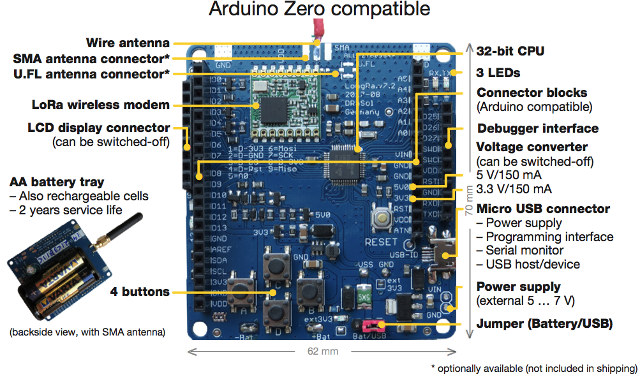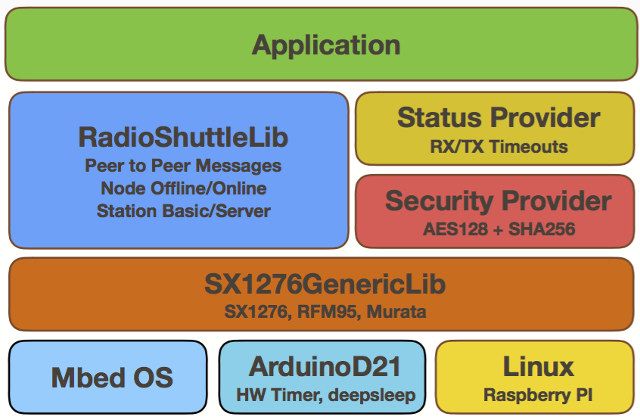LoRaWAN protocol is one of the most popular LPWAN standards used for the Internet of Things today, but some people found it “lacked efficiency, did not support direct node-to-node communication, and was too costly and far too complicated for many applications”, so they developed their own LoRa wireless protocol software called RadioShuttle, which they claim is “capable of efficiently sending messages in a fast and secure way between simple LoRa modules”.
Some of the key features of the protocol include:
- Support for secure or insecure (less time/energy) message transmission, multiple messages transmission in parallel
- Unique 32-bit device ID (device number) per LoRa member, unique 16-bit app ID (program number for the communication)
- Security – Login with SHA-256 encrypt password; AES-128 message encryption
- Air Traffic Control – Nodes only send if no LoRa signal is active on that channel.
- Optimized protocol – Message delivery within 110 ms (SF7, 125 kHz, free channel provided); default LoRa bandwidth 125 kHz (125/250/500 kHz adjustable), as narrow bandwidths allow for a longer range; Automatic transmitting power adjustment
- Operating modes
- Station, constant power supply recommended – 12 mA in receiving mode, transmitting mode (20 to 100 mA)
- Node Online (permanently receiving), constant power supply recommended – 12 mA in receiving mode, transmitting mode (20 to 100 mA)
- Wireless sensor (Node Offline checking) – Node reports back regularly. 1 µA in standby mode, battery operation for years.
- Wireless sensor (Node Offline) – Node only active if events are reported. 1 µA in standby mode, battery operation for years.
The Radioshuttle library has a low memory and storage footprint with current requirements of
- 100 kB Flash for RadioShuttle library with SHA256 & AES
- 10 kB RAM for Node Offline/Checking/Online mode
- 10 kB RAM for Station Basic mode (RAM depends on the number of nodes)
- 1 MB RAM for Station Server mode (Raspberry Pi, 10,000 LoRa nodes)
The solution supports various Arduino boards, some ARM Mbed boards (e,g, STM32L0, STM32L4), and Linux capable boards like Raspberry Pi or Orange Pi (planned). Semtech SX1276MB1MAS and SX1276MB1LAS (SX1276-based), MURATA CMWX1ZZABZ-078/091 (found in STM32 Discovery kit for LoRaWAN), and HopeRF RFM95 transceivers are supported.

The developers have also designed their own LongRa board, compatible with Arduino Zero, based on Semtech SX1276 LoRa radio chip with a 168 dB link budget and support for 868 MHz & 915 MHz frequency. The board can be powered by its micro USB port, or by two AA batteries if you’re going to use the board as a wireless sensor node.
RadioShuttle protocol is not open source for now, and while it support multiple devices as stated previsouly, if you are not using LongRa board, a 25 Euros license is required per device.

Jean-Luc started CNX Software in 2010 as a part-time endeavor, before quitting his job as a software engineering manager, and starting to write daily news, and reviews full time later in 2011.
Support CNX Software! Donate via cryptocurrencies, become a Patron on Patreon, or purchase goods on Amazon or Aliexpress






It was too good to be true, use LongRa-board or pay 25e per device.
http://www.radioshuttle.de/en/radioshuttle-2/q_a/
@Pertti Erkkilä
Oh that’s why I could not find the library or source code… I’ve updated the post accordingly.
Not open source, then it will die. It’s probably already dead. It’s like tcpip not being open. Won’t work.
D.O.A. R.I.P.
Their website (en) currently bit bare, as yet, no pricing or event contact details
@zoobab
Yep, I think you are right. This type of library should be open source. Otherwise it makes the adoption harder, so nobody will use it. You can build consulting etc. around it, if you need the money. Support, Consulting, Enterprise Versions etc.